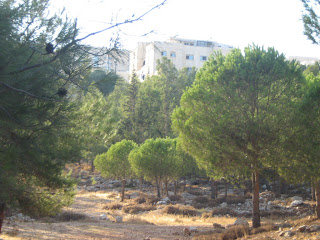June 26th
Hoopoes: 1 foraging on creek path, one flying up path earlier.. possibly same bird, though there are at least three individuals around that area.







 As I write 'our' orange tufted sunbirds are calling squeakily in the Bauhinia right outside my window and it will be dusk in a little over half an hour. The tree looks like a string bean tree right now, but not edible beans! It was hard for husband to tear me away from gazelle field today.. as usual I was reluctant to leave the bunker ruins.
As I write 'our' orange tufted sunbirds are calling squeakily in the Bauhinia right outside my window and it will be dusk in a little over half an hour. The tree looks like a string bean tree right now, but not edible beans! It was hard for husband to tear me away from gazelle field today.. as usual I was reluctant to leave the bunker ruins.
European Bee-eaters (creative commons)
 This interesting shot caught by my 11 yr old son shows hoopoe with wings and crest spread.
This interesting shot caught by my 11 yr old son shows hoopoe with wings and crest spread.

"Bob" the black- eared wheatear, lichen on limestone and an aromatic bushy shrub found all over the hill, fragrance like oregano.. from shape of flowers definitely mint family but this pic doesn't show that.
All pics taken with our casio digital
Today we went out a little after 5 p.m. to- after 7 p.m. humidity 70% and rising, just under 22 degrees C and falling, wind WNW vearing SW at just under 8 knots
For a change we took a hike up the hill to the east of the valley just a few hundred feet above level of valley floor and a nice little work- out up old goat trails over limestone covered with lichens and winding between springy cushions of wonderfully aromatic plants with purple blooms.. fragrance of rich oregano. Lovely and invigorating. I'd hoped for larks but possibly the wind kept them down. We did find a group of Hooded Crows apparently having a lark
I'd seen them from down below but now we were amongst them. I had already come to the conclusion they were just playing but watching them now, a group of about twenty five of them over the western slopes of the hill, we realized they were wind surfing! They were picking up the gusts of wind as they arrived at the hill and then riding on them. There was no survival purpose at all.. they were simply having fun! It was all very Alfred Hitchcockish esp when they started wheeling aobut over our heads cawing. Maybe we'd messed up their game by introducing unpredictable turbulence, or we just alarmed them a little. I had often wondered if crows had learned that black tubes carried by humans are trouble. They're smart birds and could have learned to associate black tubes with guns and I was carrying my binoculars as usual. For a couple of minutes they were cawing and wheeling around above us seeming agitated and annoyed, though too scared to approach closer.. then when they saw we were no real threat they went back to their wind surfing.
1 gazelle female over near the trees as usual on gazelle field.
It was really hard to tear myself away today but we had to get back if we're going to be responsible parents. It was so sweet at that corner of gazelle field, wood and orchard with greenfinches singing, bee-eaters hunting, dancing in the air above us, turtle doves purring and views of gazelle field and the cistern.. .. I could easily have stay there till dark. Ahhhh! not only charming but so promising! Another day....
 Honey Buzzard M. Panuccio
Honey Buzzard M. Panuccio
Pessimistic Prediction #1 - that the planting of saplings in the field near the Pumping station would put off the wheatears.
Wrong!
We saw (part of) a whole family there today and absolutely gorgeous. A magnificent male Black eared wheatear (Oenanthe hispanica melanoleuca) in summer plumage hopped and chirped on the rocks quite close to us, often not more than twenty feet in front of us.. for all the world looking like he was attracting our attention. I believe he was, he put on quite a performance, enchanted us with calls, posturings and posings for some minutes. The photograph above shows a male in spring plumage. In summer plumage the black has retreated further from the bib revealing more white, and his feathers are mostly snow white all over. He was enchanting! .. we could see the silky white and cream of his breast plumage.
A little while later he crossed the field and visited a mound of earth and boulders. On it, perched, still and almost totally camouflaged was a juvenile wheater. Dad visited it quite briefly, no doubt hoping us humans wouldn't notice. These humans were equipped with 10x50 Bushnells and we did :) It was very likely Mom and other juveniles were around but under cover of grasses. He then flew down by the saplings and visited a third wheatear that had a much more extensive dark chin and black and brown wings but pretty much white everywhere else but the centre and tips of tail, which were black. Plumage contrasting too much to be a female I thought.. first year male? His son from last year? The two interacted several times though socially, not aggressively.


